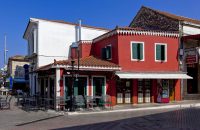Kassopi, the capital of Kassopaea, was built before the middle of the 4th century BC in a naturally fortified position, on a plateau with an altitude of 550-650m., on the slopes of Zalongos, in order to protect the fertile plain that stretched southwards from the exploitation of the Ilian colonists. The great prosperity of the city is noted in the 3rd century BC when the large public buildings were built and many houses were rebuilt.
Within its polygonal enclosure, walls 3.20-3.50m thick, – there were about 600 two-storey houses on plots of 230m2, all with a meridian orientation and excellent construction and functionality, connected by a street and a common drainage corridor with a special covered sewer.
Kassopi was founded in the first half of the 4th century BC with a settlement of towns of the wider region. From the beginning it was organized as a “city-state”, and was the capital of the tribe of the Kassopians. The city’s location at a key geographical point enabled it to control both the hinterland and the coast. Cassopi was organised according to a geometric urban planning system, in which a grid of horizontal and vertical streets formed building islands, which had an excellent drainage system. To fortify the city, a strong polygonal wall was built at vulnerable points.
The centre of public life was the civil market located to the south-east of Kassopi, offering a panoramic view of the Ambracian Gulf and the Ionian Sea. The form of the market was consolidated at the end of the 3rd century BC, when the flourishing city had around 10 000 inhabitants. To the north and west it was flanked by two stoas, with a Doric colonnade on the façade, and to the east by the Dio or Bouleuterion. The north lodge on the front and east side had pedestals of statues, dedications to the city. Behind the West Gallery extended the Prytaneion, which was the administrative centre and the seat of the rectors. To the north of the Agora is the Dwelling House, a monumental building that served either as a public hostel or as the city’s commercial market. At the north-western end is the large theatre, with a capacity of about 6 000 spectators, while at the south-western end, an underground chamber tomb is interpreted as the Hero of the founder.
Outside the walls of Kassopi, at the neck of the Zalongo, are the foundations of a small pavilion temple, attributed to Aphrodite, patron goddess of the Kassopians.
The destruction of the continental cities by the Romans in 167 BC affected Kassopi, but their final abandonment is linked to the foundation of Nicopolis in 31 BC, when the inhabitants were forced to settle in the new city.
At presen in the archaeological site of Kassopi, work is under way to improve and enhance both the central part of the town and the large theatre, after which visitors will be able to gain a complete picture of the urban planning and operation of a Hellenistic town. The archaeological site of Kassopi covers an area of approximately 350 hectares and is located 27 km from Preveza.
















